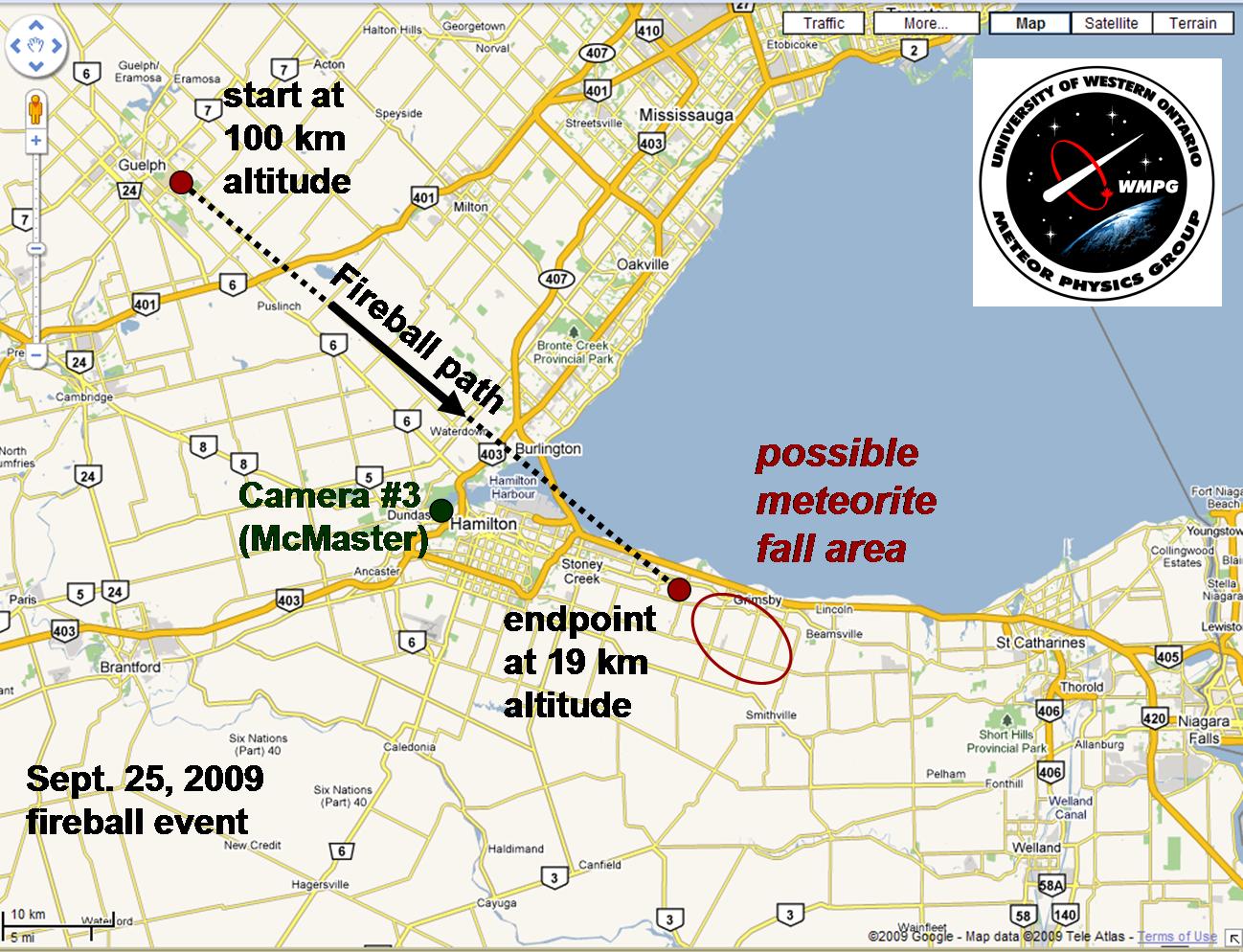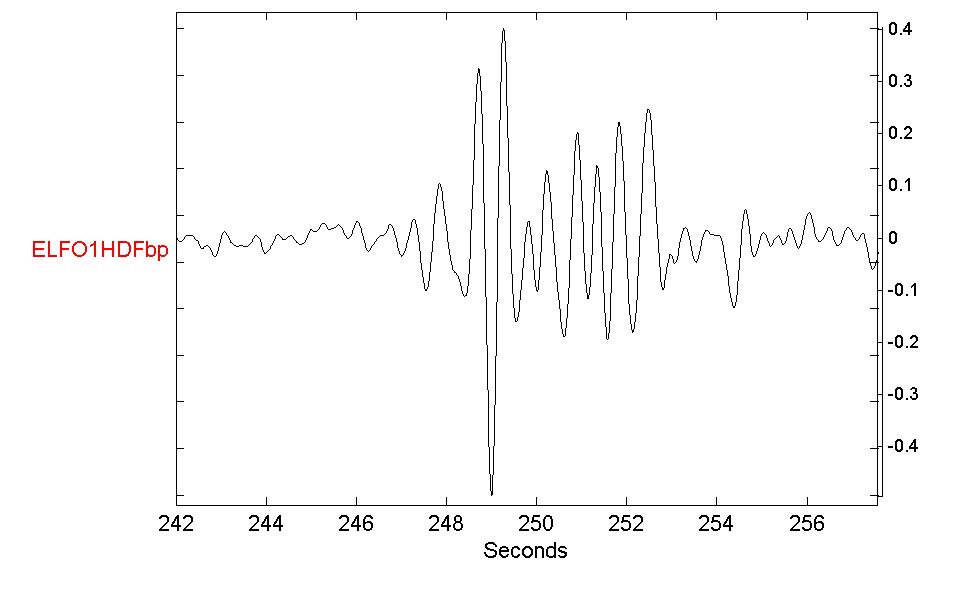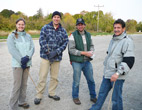SOMN Fireball event of September 25, 2009
At 9:03 pm on Friday night September 25, 2009 (01:03 UT Sept 26) seven all-sky cameras of Western's Southern Ontario Meteor Network (SOMN) recorded a brilliant fireball in the evening sky over the west end of Lake Ontario.
The fireball was seen widely by observers throughout southern Ontario and adjacent areas. The fireball was first detected by Western's camera systems at an altitude of 100km over Guelph moving southeastwards at 20.8 km/s. The meteoroid was initially the size of a child's tricycle. At its brightest, the fireball was approximately 100 times as bright as the full moon.
Composite photo [click to enlarge]

Composite all-sky camera image of the end of the fireball as seen from Hamilton (Camera #3, McMaster). Available below are movies of the event as seen by several of the SOMN cameras, as well as animations of the object's arrival at Earth. [click to enlarge]
Analysis of the all-sky camera records as well as data from Western's meteor radar and infrasound equipment indicates that this bright fireball was large enough to have dropped meteorites in a region south of Grimsby on the Niagara Peninsula, providing masses that may total as much as several kilograms.
Fireball Path Image [Click to Enlarge]

Ground track and projected meteorite fall area for the September 25th Grimsby fireball, as derived from Western's all-sky camera network. The location of the closest camera, hosted by McMaster University in Hamilton, is also shown.
Researchers at Western are interested in hearing from anyone within 10 km of Grimsby who may have witnessed or recorded this evening event, seen or heard unusual events at the time, or who may have found possible fragments of the freshly fallen meteorite.
Meteorites are of great scientific value. Note that, in Canada, meteorites belong to the owner of the land upon which they are discovered. If you intend to search, please obtain the permission of the land owner before searching on private land.
Meteorites may best be recognized by their dark and scalloped exterior, and are usually more dense than normal rock and will often attract a fridge magnet due to their metal content. In this fall meteorites may well occur in a small hole produced by their dropping into soil. Meteorites are not dangerous, but we request that any recovered meteorites be placed in a clean plastic bag or container and be handled as little as possible to preserve their scientific information.
If you have questions, observations or possible meteorites from this Sept. 25th event, please contact:
- Dr. Phil McCausland
- Phone: (519) 661-2111 ext-87985 (UWO Meteor Physics Lab)
- Cell: (519) 694-3323
- http://aquarid.physics.uwo.ca/
- e-mail: pmccausl at uwo.ca
For more information on the Southern Ontario Meteor Network (SOMN) all-sky cameras, or on Western's meteor radar (CMOR), please contact Rob Weryk:[rjweryk at uwo.ca]
For Western's infrasound array, please contact Elizabeth Silber: [elizabeth.silber at uwo.ca]
For more information on the animations of this event, please contact
David Clark: [dclark56 at uwo.ca]
All sky Camera videos from these locations:
- DVD ISO image composite of all videos - NEW Oct.17, 2009
- VOB file for above DVD composite - NEW Oct.17, 2009
- Camera #01 UWO
- Camera #02 Elginfield
- Camera #03 Hamilton (McMaster)
- Camera #04 Tavistock
- Camera #06 Orangeville
Infrasound Image [Click to Enlarge]

Microvariation of atmospheric pressure, in Pascals, over time from the Grimsby fireball event, as recorded by sensitive barometers at Western's infrasound array north of London, Ontario.
This animation shows the relative orbits of the small asteroid ("20090926") and the Earth (in green) prior to its collision with the Earth, rotated to show a three-dimensional view of the inner solar system. The animation is then run forward in time such that the small asteroid collides with the Earth; we are then shown the "asteroid's-eye" view as it approaches the rotating Earth until collision. The red dots distributed throughout southwest Ontario are the all-sky camera locations, with the final dot representing the possible meteorite fall area southeast of Hamilton, Ontario. Animation credit David Clark, UWO: dclark56 at uwo.ca
An animation of the final approach and collision of the small asteroid with the Earth, as viewed from the south. The steep angle of entry can be readily seen in this view. Animation credit David Clark, UWO: [dclark56 at uwo.ca]
We would like to take this opportunity to acknowledge the camera operators for each of our partner sites for kindly hosting network cameras, helping to maintain and ensure their smooth operation:
- Asgard 03 - Doug Welch (Dept of Physics and Astronomy, McMaster University)
- Asgard 05 - Carr Astronomical Observatory (RASC - Toronto Center)
- Asgard 06 - Marc Castel (Robosky)
- Asgard 07 - Paul Zelichowski - Bruce County Astronomical Society






